Amir Zamir
How Well Does GPT-4o Understand Vision? Evaluating Multimodal Foundation Models on Standard Computer Vision Tasks
Jul 02, 2025Abstract:Multimodal foundation models, such as GPT-4o, have recently made remarkable progress, but it is not clear where exactly these models stand in terms of understanding vision. In this paper, we benchmark the performance of popular multimodal foundation models (GPT-4o, o4-mini, Gemini 1.5 Pro and Gemini 2.0 Flash, Claude 3.5 Sonnet, Qwen2-VL, Llama 3.2) on standard computer vision tasks (semantic segmentation, object detection, image classification, depth and surface normal prediction) using established datasets (e.g., COCO, ImageNet and its variants, etc). The main challenges to performing this are: 1) most models are trained to output text and cannot natively express versatile domains, such as segments or 3D geometry, and 2) many leading models are proprietary and accessible only at an API level, i.e., there is no weight access to adapt them. We address these challenges by translating standard vision tasks into equivalent text-promptable and API-compatible tasks via prompt chaining to create a standardized benchmarking framework. We observe that 1) the models are not close to the state-of-the-art specialist models at any task. However, 2) they are respectable generalists; this is remarkable as they are presumably trained on primarily image-text-based tasks. 3) They perform semantic tasks notably better than geometric ones. 4) While the prompt-chaining techniques affect performance, better models exhibit less sensitivity to prompt variations. 5) GPT-4o performs the best among non-reasoning models, securing the top position in 4 out of 6 tasks, 6) reasoning models, e.g. o3, show improvements in geometric tasks, and 7) a preliminary analysis of models with native image generation, like the latest GPT-4o, shows they exhibit quirks like hallucinations and spatial misalignments.
Large (Vision) Language Models are Unsupervised In-Context Learners
Apr 03, 2025Abstract:Recent advances in large language and vision-language models have enabled zero-shot inference, allowing models to solve new tasks without task-specific training. Various adaptation techniques such as prompt engineering, In-Context Learning (ICL), and supervised fine-tuning can further enhance the model's performance on a downstream task, but they require substantial manual effort to construct effective prompts or labeled examples. In this work, we introduce a joint inference framework for fully unsupervised adaptation, eliminating the need for manual prompt engineering and labeled examples. Unlike zero-shot inference, which makes independent predictions, the joint inference makes predictions simultaneously for all inputs in a given task. Since direct joint inference involves computationally expensive optimization, we develop efficient approximation techniques, leading to two unsupervised adaptation methods: unsupervised fine-tuning and unsupervised ICL. We demonstrate the effectiveness of our methods across diverse tasks and models, including language-only Llama-3.1 on natural language processing tasks, reasoning-oriented Qwen2.5-Math on grade school math problems, vision-language OpenFlamingo on vision tasks, and the API-only access GPT-4o model on massive multi-discipline tasks. Our experiments demonstrate substantial improvements over the standard zero-shot approach, including 39% absolute improvement on the challenging GSM8K math reasoning dataset. Remarkably, despite being fully unsupervised, our framework often performs on par with supervised approaches that rely on ground truth labels.
FlexTok: Resampling Images into 1D Token Sequences of Flexible Length
Feb 19, 2025Abstract:Image tokenization has enabled major advances in autoregressive image generation by providing compressed, discrete representations that are more efficient to process than raw pixels. While traditional approaches use 2D grid tokenization, recent methods like TiTok have shown that 1D tokenization can achieve high generation quality by eliminating grid redundancies. However, these methods typically use a fixed number of tokens and thus cannot adapt to an image's inherent complexity. We introduce FlexTok, a tokenizer that projects 2D images into variable-length, ordered 1D token sequences. For example, a 256x256 image can be resampled into anywhere from 1 to 256 discrete tokens, hierarchically and semantically compressing its information. By training a rectified flow model as the decoder and using nested dropout, FlexTok produces plausible reconstructions regardless of the chosen token sequence length. We evaluate our approach in an autoregressive generation setting using a simple GPT-style Transformer. On ImageNet, this approach achieves an FID<2 across 8 to 128 tokens, outperforming TiTok and matching state-of-the-art methods with far fewer tokens. We further extend the model to support to text-conditioned image generation and examine how FlexTok relates to traditional 2D tokenization. A key finding is that FlexTok enables next-token prediction to describe images in a coarse-to-fine "visual vocabulary", and that the number of tokens to generate depends on the complexity of the generation task.
ViPer: Visual Personalization of Generative Models via Individual Preference Learning
Jul 24, 2024
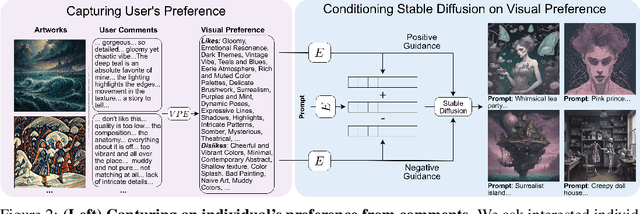

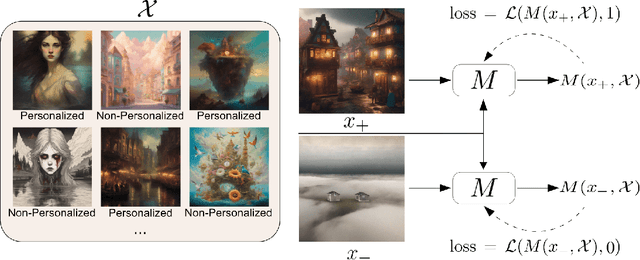
Abstract:Different users find different images generated for the same prompt desirable. This gives rise to personalized image generation which involves creating images aligned with an individual's visual preference. Current generative models are, however, unpersonalized, as they are tuned to produce outputs that appeal to a broad audience. Using them to generate images aligned with individual users relies on iterative manual prompt engineering by the user which is inefficient and undesirable. We propose to personalize the image generation process by first capturing the generic preferences of the user in a one-time process by inviting them to comment on a small selection of images, explaining why they like or dislike each. Based on these comments, we infer a user's structured liked and disliked visual attributes, i.e., their visual preference, using a large language model. These attributes are used to guide a text-to-image model toward producing images that are tuned towards the individual user's visual preference. Through a series of user studies and large language model guided evaluations, we demonstrate that the proposed method results in generations that are well aligned with individual users' visual preferences.
Solving Vision Tasks with Simple Photoreceptors Instead of Cameras
Jun 17, 2024Abstract:A de facto standard in solving computer vision problems is to use a common high-resolution camera and choose its placement on an agent (i.e., position and orientation) based on human intuition. On the other hand, extremely simple and well-designed visual sensors found throughout nature allow many organisms to perform diverse, complex behaviors. In this work, motivated by these examples, we raise the following questions: 1. How effective simple visual sensors are in solving vision tasks? 2. What role does their design play in their effectiveness? We explore simple sensors with resolutions as low as one-by-one pixel, representing a single photoreceptor First, we demonstrate that just a few photoreceptors can be enough to solve many tasks, such as visual navigation and continuous control, reasonably well, with performance comparable to that of a high-resolution camera. Second, we show that the design of these simple visual sensors plays a crucial role in their ability to provide useful information and successfully solve these tasks. To find a well-performing design, we present a computational design optimization algorithm and evaluate its effectiveness across different tasks and domains, showing promising results. Finally, we perform a human survey to evaluate the effectiveness of intuitive designs devised manually by humans, showing that the computationally found design is among the best designs in most cases.
4M-21: An Any-to-Any Vision Model for Tens of Tasks and Modalities
Jun 14, 2024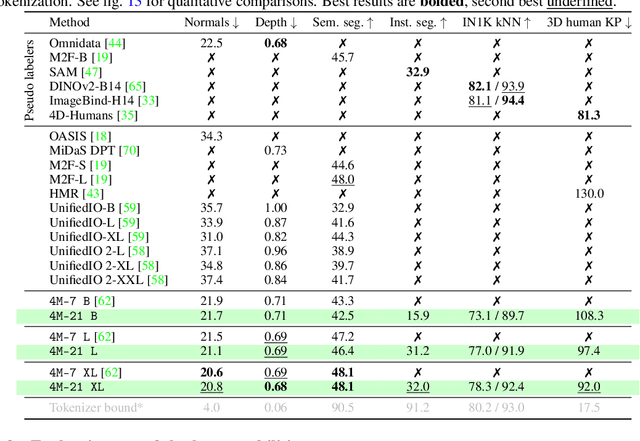
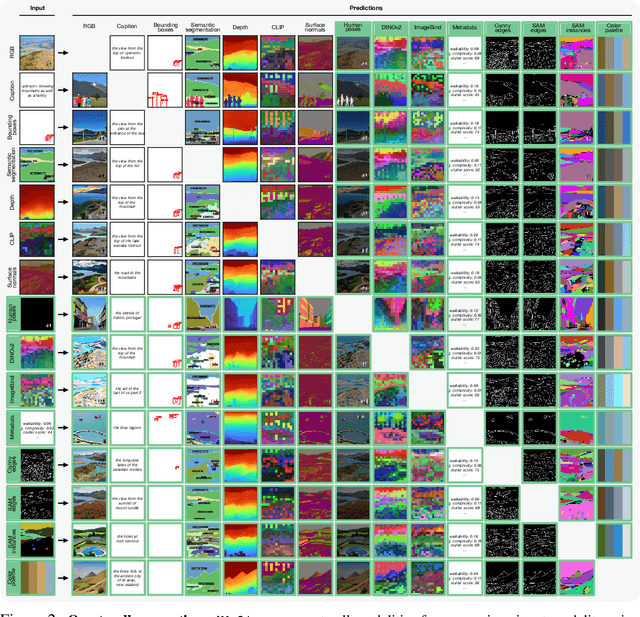
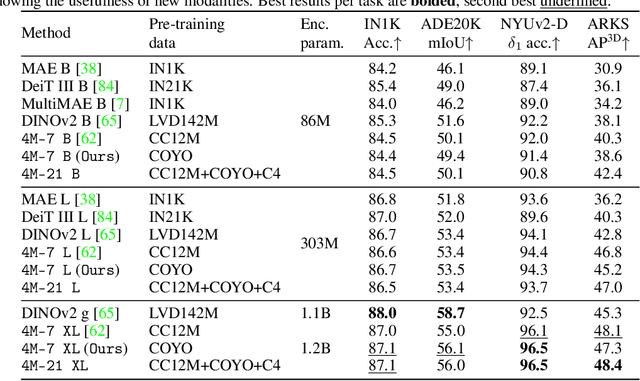
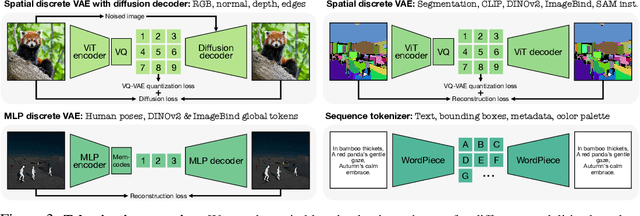
Abstract:Current multimodal and multitask foundation models like 4M or UnifiedIO show promising results, but in practice their out-of-the-box abilities to accept diverse inputs and perform diverse tasks are limited by the (usually rather small) number of modalities and tasks they are trained on. In this paper, we expand upon the capabilities of them by training a single model on tens of highly diverse modalities and by performing co-training on large-scale multimodal datasets and text corpora. This includes training on several semantic and geometric modalities, feature maps from recent state of the art models like DINOv2 and ImageBind, pseudo labels of specialist models like SAM and 4DHumans, and a range of new modalities that allow for novel ways to interact with the model and steer the generation, for example image metadata or color palettes. A crucial step in this process is performing discrete tokenization on various modalities, whether they are image-like, neural network feature maps, vectors, structured data like instance segmentation or human poses, or data that can be represented as text. Through this, we expand on the out-of-the-box capabilities of multimodal models and specifically show the possibility of training one model to solve at least 3x more tasks/modalities than existing ones and doing so without a loss in performance. This enables more fine-grained and controllable multimodal generation capabilities and allows us to study the distillation of models trained on diverse data and objectives into a unified model. We successfully scale the training to a three billion parameter model using tens of modalities and different datasets. The resulting models and training code are open sourced at 4m.epfl.ch.
BRAVE: Broadening the visual encoding of vision-language models
Apr 10, 2024Abstract:Vision-language models (VLMs) are typically composed of a vision encoder, e.g. CLIP, and a language model (LM) that interprets the encoded features to solve downstream tasks. Despite remarkable progress, VLMs are subject to several shortcomings due to the limited capabilities of vision encoders, e.g. "blindness" to certain image features, visual hallucination, etc. To address these issues, we study broadening the visual encoding capabilities of VLMs. We first comprehensively benchmark several vision encoders with different inductive biases for solving VLM tasks. We observe that there is no single encoding configuration that consistently achieves top performance across different tasks, and encoders with different biases can perform surprisingly similarly. Motivated by this, we introduce a method, named BRAVE, that consolidates features from multiple frozen encoders into a more versatile representation that can be directly fed as the input to a frozen LM. BRAVE achieves state-of-the-art performance on a broad range of captioning and VQA benchmarks and significantly reduces the aforementioned issues of VLMs, while requiring a smaller number of trainable parameters than existing methods and having a more compressed representation. Our results highlight the potential of incorporating different visual biases for a more broad and contextualized visual understanding of VLMs.
Controlled Training Data Generation with Diffusion Models
Mar 22, 2024Abstract:In this work, we present a method to control a text-to-image generative model to produce training data specifically "useful" for supervised learning. Unlike previous works that employ an open-loop approach and pre-define prompts to generate new data using either a language model or human expertise, we develop an automated closed-loop system which involves two feedback mechanisms. The first mechanism uses feedback from a given supervised model and finds adversarial prompts that result in image generations that maximize the model loss. While these adversarial prompts result in diverse data informed by the model, they are not informed of the target distribution, which can be inefficient. Therefore, we introduce the second feedback mechanism that guides the generation process towards a certain target distribution. We call the method combining these two mechanisms Guided Adversarial Prompts. We perform our evaluations on different tasks, datasets and architectures, with different types of distribution shifts (spuriously correlated data, unseen domains) and demonstrate the efficiency of the proposed feedback mechanisms compared to open-loop approaches.
Unraveling the Key Components of OOD Generalization via Diversification
Dec 26, 2023Abstract:Real-world datasets may contain multiple features that explain the training data equally well, i.e., learning any of them would lead to correct predictions on the training data. However, many of them can be spurious, i.e., lose their predictive power under a distribution shift and fail to generalize to out-of-distribution (OOD) data. Recently developed ``diversification'' methods approach this problem by finding multiple diverse hypotheses that rely on different features. This paper aims to study this class of methods and identify the key components contributing to their OOD generalization abilities. We show that (1) diversification methods are highly sensitive to the distribution of the unlabeled data used for diversification and can underperform significantly when away from a method-specific sweet spot. (2) Diversification alone is insufficient for OOD generalization. The choice of the used learning algorithm, e.g., the model's architecture and pretraining, is crucial, and using the second-best choice leads to an up to 20% absolute drop in accuracy.(3) The optimal choice of learning algorithm depends on the unlabeled data, and vice versa.Finally, we show that the above pitfalls cannot be alleviated by increasing the number of diverse hypotheses, allegedly the major feature of diversification methods. These findings provide a clearer understanding of the critical design factors influencing the OOD generalization of diversification methods. They can guide practitioners in how to use the existing methods best and guide researchers in developing new, better ones.
4M: Massively Multimodal Masked Modeling
Dec 11, 2023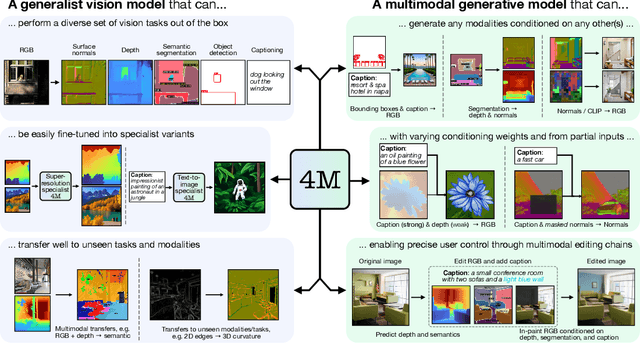

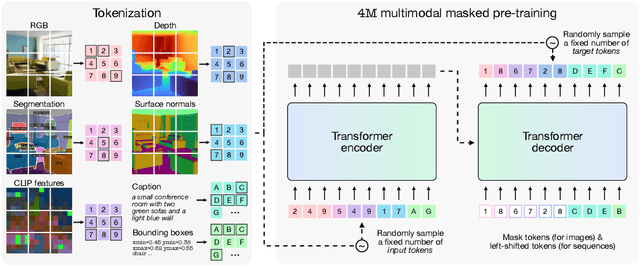

Abstract:Current machine learning models for vision are often highly specialized and limited to a single modality and task. In contrast, recent large language models exhibit a wide range of capabilities, hinting at a possibility for similarly versatile models in computer vision. In this paper, we take a step in this direction and propose a multimodal training scheme called 4M. It consists of training a single unified Transformer encoder-decoder using a masked modeling objective across a wide range of input/output modalities - including text, images, geometric, and semantic modalities, as well as neural network feature maps. 4M achieves scalability by unifying the representation space of all modalities through mapping them into discrete tokens and performing multimodal masked modeling on a small randomized subset of tokens. 4M leads to models that exhibit several key capabilities: (1) they can perform a diverse set of vision tasks out of the box, (2) they excel when fine-tuned for unseen downstream tasks or new input modalities, and (3) they can function as a generative model that can be conditioned on arbitrary modalities, enabling a wide variety of expressive multimodal editing capabilities with remarkable flexibility. Through experimental analyses, we demonstrate the potential of 4M for training versatile and scalable foundation models for vision tasks, setting the stage for further exploration in multimodal learning for vision and other domains.
 Add to Chrome
Add to Chrome Add to Firefox
Add to Firefox Add to Edge
Add to Edge